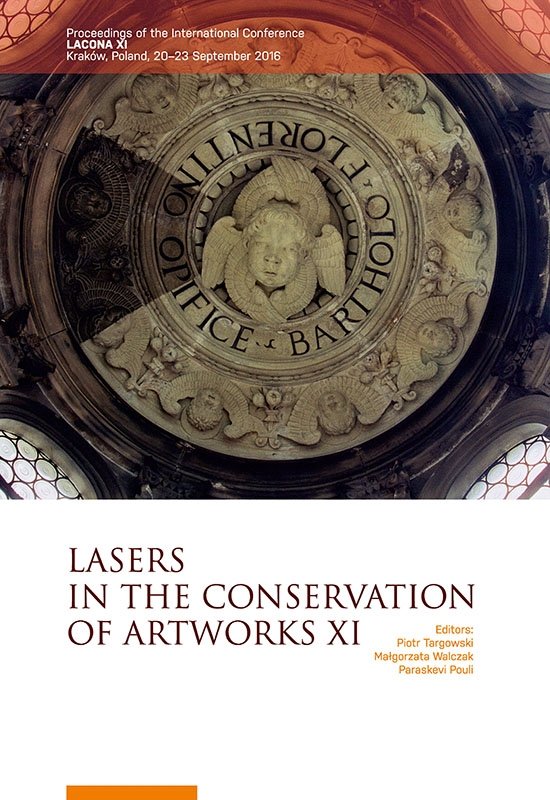Lasers in the Conservation of Artworks XI. Proceedings of the International Conference LACONA XI, Kraków, Poland, 20–23 September 2016
The eleventh conference on Lasers in the Conservation of Artworks has been the latest of the LACONA conference series, initiated more than 20 years ago – in 1995 – by Costas Fotakis and held in FORTH in Heraklion, Greece. The present edition was held in Kraków, Poland, hosted by the Jan Matejko Academy of Fine Arts. It was co-organized by Nicolaus Copernicus University in Toruń, The Interacademic Institute of Conservation and Restoration of Art in Warszawa and Kraków, and, last but not least, by the National Museum in Kraków.
The early editions of LACONA were devoted mostly to the application of lasers to cleaning of artworks, which, at the time, was an emerging topic. Today, we prefer to talk about “removal of unwanted layers and coatings” to emphasize that this application now goes far beyond simple “cleaning” and has become – for many classes of objects – a mature procedure, widely accepted within the conservation/restoration community. Nevertheless, its effective and safe application to specific objects remains a subject of extensive study. Also, continual progress in the development of lasers, especially by utilizing the ultra-short pulses provided by compact and less expensive sources, opens new areas of application by placing a broader set of tools in the hands of the conservator/restorer. Another significant feature of recent LACONA conferences is the much broader range of subjects presented, since the application of lasers in the conservation of artworks covers much more than simply “laser cleaning”. Appropriate restoration procedures are always preceded by examination and laser techniques – or, more broadly speaking, techniques utilizing coherent light – such as LIBS, Raman spectroscopy, optical coherence tomography and nonlinear or two-photon laser microscopy, feature regularly as significant subjects at LACONA.
A specific aim for the LACONA series has always been to bring together conservation scientists active in the field of developing methods and instruments with practising restorers and conservators who are the most important recipients of these new developments. Without the professional knowledge and experience of the latter it would not be possible to implement any of the results obtained in laboratory research in conservation practice. Therefore, LACONA has always been a unique forum for the exchange of ideas between scientists and practitioners.
This volume comprises 20 peer-review research articles submitted by participants after the conference. They are organised in three chapters covering laser ablation, coherent light-related analytical techniques and case studies. Additionally, the first chapter contains two key-note articles, describing lesser-known aspects of the history of use of light and lasers in the context of preservation of cultural heritage.
Editors:
Piotr Targowski, Nicolaus Copernicus University in Toruń, Poland
Małgorzata Walczak, Th e Jan Matejko Academy of Fine Arts in Kraków, Poland
Paraskevi Pouli, Institute of Electronic Structure & Laser, Foundation for Research and Technology – Hellas (FORTH), Heraklion, Crete, Greece
Organisers:
The Jan Matejko Academy of Fine Arts in Kraków
Nicolaus Copernicus University in Toruń
The Interacademic Institute of Conservation and Restoration of Art, Warszawa/Kraków
The National Museum in Kraków
Powiązane

Pielęgnacja świątyni i innych zabytków. Książka nie tylko dla księży
Bogumiła J. Rouba
Wełniane tekstylia pospólstwa i plebsu gdańskiego (XIV-XVII w.) i ich konserwacja
Małgorzata Grupa
Współczesne metody badań obrazów sztalugowych. Podręcznik konserwatora - restauratora
Daniela Pinna, Monica Galeotti, Rococo Mazzeo
Zabytki kamienne i metalowe, ich niszczenie i konserwacja profilaktyczna
Wiesław DomasłowskiInne z tej kategorii

Tężenie solankowe. Architektoniczny i prozdrowotny fenomen

Piękno nieoczywiste. Konserwacja przedmiotów użytku codziennego ze zbiorów Muzeum Narodowego Ziemi Przemyskiej oraz Wielkopolskiego Muzeum Niepodległości
Aleksandra Gralińska-Grubecka, Zuzanna Jarmulska-Król, Adam Kaźmierczak, Piotr Maćko, Piotr Niemcewicz, Agata Ogińska, Arletta Piasecka, Grażyna Szczepańska
Świat z perspektywy sztuki, sztuka w perspektywie świata. #Kultura wizualna. Tom 7







